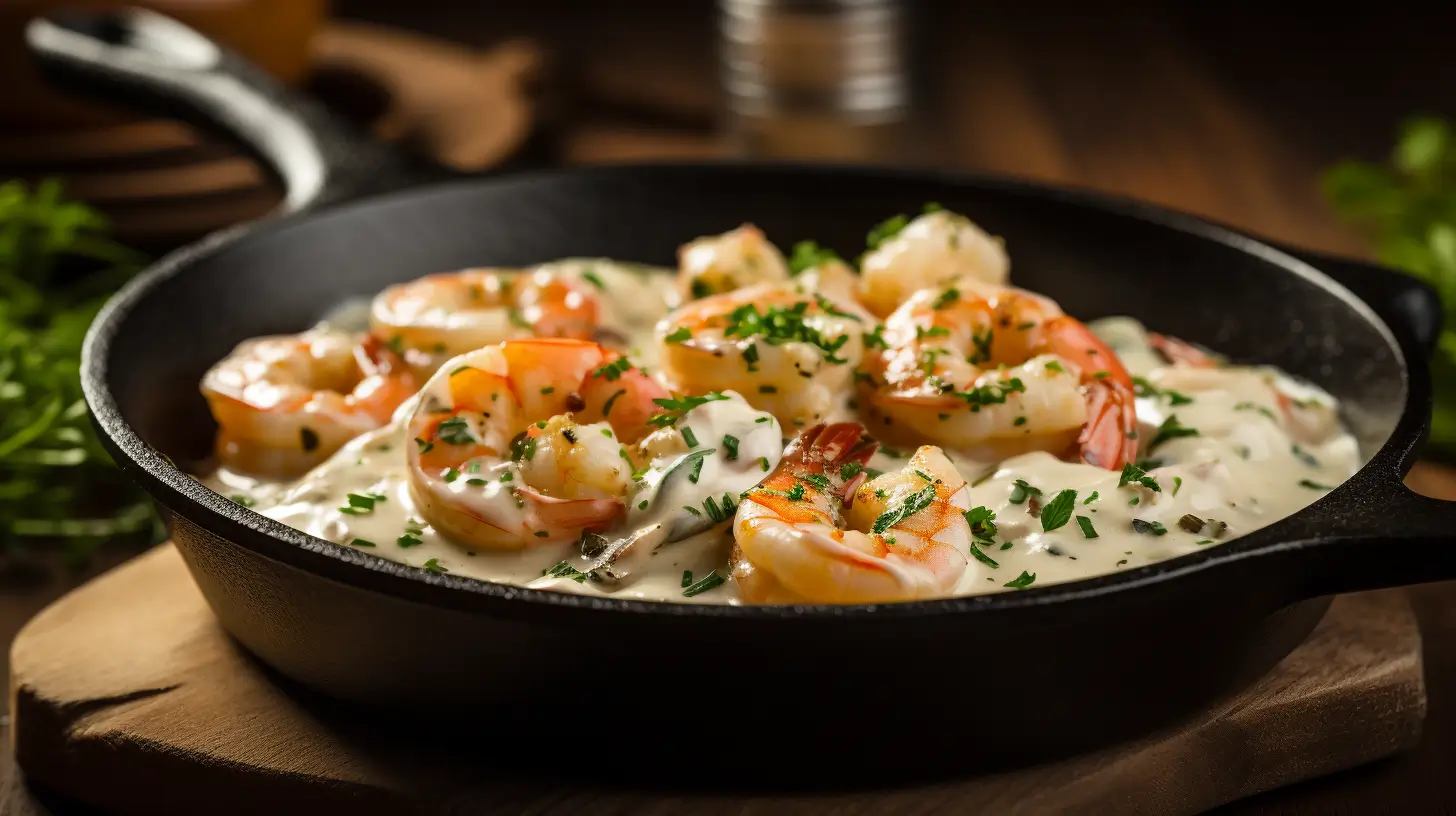French crêpes are more than just a dish—they are a window into France’s rich culinary tradition, reflecting a history steeped in celebration, creativity, and shared moments. Delicately thin and endlessly versatile, these iconic treats have charmed palates around the world, yet they remain deeply rooted in French culture. From their origins in the Brittany region to their enduring presence at family tables and festive occasions, crêpes embody the spirit of French cuisine: simple yet sophisticated.
1. Introduction to Authentic French Crêpes
Crêpes are a cornerstone of French cuisine, loved for their adaptability and universal appeal. In France, they are not only a favourite at home but also a staple at food markets, street stalls, and crêperies. They hold particular importance on La Chandeleur (Candlemas Day), where families gather to make and enjoy crêpes as a symbol of good fortune and prosperity.
Why French Crêpes Are Different from Pancakes
Unlike pancakes, which are thick and fluffy, French crêpes are thin and delicate, with a smooth, pliable texture. This distinct characteristic makes them ideal for wrapping around sweet or savoury fillings. The batter is subtly flavoured, acting as a versatile base that complements everything from a simple dusting of sugar to decadent combinations of fruits, creams, and chocolates.
2. What Makes a Crêpe Authentic?
To achieve authentic French crêpes, precision and tradition are key. Authenticity lies in both the choice of ingredients and the techniques used during preparation.
Traditional Ingredients and Techniques
Authentic crêpes rely on simple, high-quality ingredients such as flour, milk, eggs, sugar, and butter. These staples, combined with careful mixing and resting of the batter, create a balance of flavours and textures that elevate the crêpe.
The Perfect Balance Between Thinness and Texture
The hallmark of a great crêpe is its thinness. A well-made crêpe should be thin enough to let light through but sturdy enough to hold its fillings without tearing. Achieving this requires a light batter, a hot pan, and a skilled hand to swirl the mixture evenly.
3. Key Ingredients for French Crêpes
While crêpes are built on a foundation of simplicity, each ingredient plays a crucial role in the final texture and flavour.
Essential Ingredients
- Flour: All-purpose flour is commonly used, but buckwheat flour is traditional for savoury crêpes, known as galettes.
- Milk: Provides moisture and creates a silky batter.
- Eggs: Bind the batter and contribute to its structure.
- Sugar: Adds a hint of sweetness (optional for savoury versions).
- Butter: Adds richness and prevents sticking during cooking.
Optional Additions
- Vanilla Extract: Enhances the flavour, especially in sweet crêpes.
- Orange Zest: Adds a citrusy twist for a more aromatic crêpe.
4. Essential Tools for Making Crêpes
While crêpes can be made in any kitchen, the right tools can help you achieve perfection with ease.
Must-Have Tools
- Crêpe Pan: A flat, non-stick pan with low edges ensures easy flipping and even cooking.
- Ladle: For portioning just the right amount of batter.
- Spatula: A thin, flexible spatula makes flipping crêpes effortless.
Tips for the Perfect Swirl
Swirling the batter evenly in the pan is an art. Pour a small amount of batter into the centre of the hot pan and quickly tilt it in all directions to spread the batter thinly and evenly. The key is to move swiftly before the batter sets.
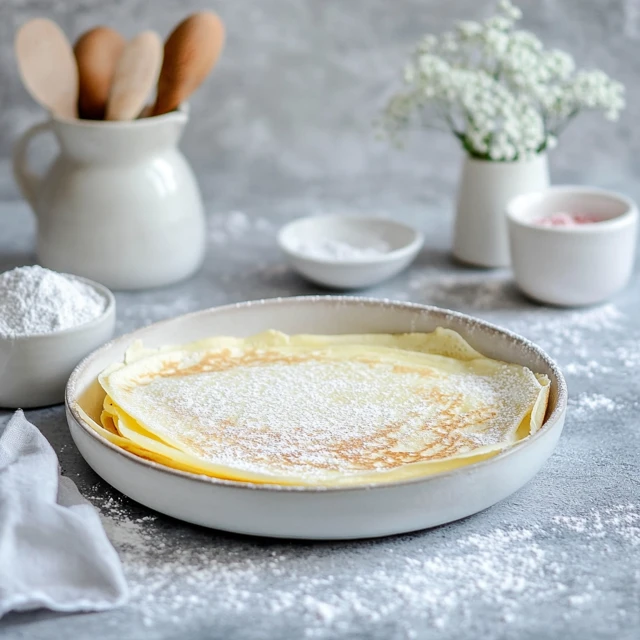
5. Step-by-Step Guide to Preparing Crêpe Batter
The foundation of any great crêpe is its batter, and proper preparation ensures a smooth, lump-free result.
Step 1: Sifting Dry Ingredients
Sift the flour into a large bowl to remove any lumps and ensure a smooth texture. Mix in sugar and salt if using.
Step 2: Combining Wet Ingredients
In a separate bowl, whisk together the eggs and milk until fully blended. Slowly pour this mixture into the dry ingredients, whisking continuously to avoid clumps.
Step 3: Adding Butter
Melted butter is incorporated last to add richness and ensure the crêpes don’t stick to the pan.
6. The Importance of Resting the Batter
Resting the batter is a critical step that many home cooks overlook, but it is essential for achieving tender crêpes.
Why Resting Matters
Resting allows the gluten in the flour to relax, resulting in softer crêpes. It also helps the ingredients meld together, creating a more cohesive batter.
How to Rest the Batter
Cover the bowl with cling film and let it sit for at least 30 minutes at room temperature. For even better results, refrigerate the batter for up to 24 hours.
7. Cooking Crêpes to Perfection
Mastering the cooking process is where practice meets skill. A few key tips will help you achieve beautifully golden crêpes every time.
Preheating the Pan
A well-heated pan is crucial. Heat it over medium-high heat and lightly grease it with butter before each crêpe.
Flipping Without Tearing
Once the edges begin to lift and the surface looks dry, it’s time to flip. Use a spatula or, for the more adventurous, a quick flick of the wrist to toss the crêpe into the air.
8. Traditional Sweet Crêpe Fillings
The beauty of crêpes lies in their versatility. Sweet crêpes are particularly popular for breakfast, dessert, or as an afternoon treat.
Classic Fillings
- A sprinkle of sugar and a squeeze of lemon juice for simplicity.
- Jams like strawberry, raspberry, or apricot.
Indulgent Combinations
- Chocolate spread with banana slices.
- Fresh fruits paired with whipped cream or custard.
9. Savoury French Galettes
Galettes, the savoury cousin of crêpes, are traditionally made with buckwheat flour and are a staple in Brittany.
What Sets Galettes Apart
Galettes are heartier and slightly more rustic in appearance compared to traditional crêpes. They are typically served as a meal rather than a dessert.
Filling Ideas
- Ham, cheese, and egg, known as the Galette Complète.
- Sautéed vegetables, smoked salmon, or even ratatouille for a modern twist.
10. The History of Crêpes in French Cuisine
Crêpes date back to the 13th century in Brittany, where they were originally made with buckwheat flour. Over time, they evolved into the versatile dish we know today, with sweet and savoury variations becoming staples in French households. Their association with celebrations like La Chandeleur has cemented their place in France’s culinary heritage, making them a beloved tradition that continues to be enjoyed worldwide.
French crêpes are a testament to the elegance and simplicity of French cuisine. With the right ingredients, tools, and techniques, anyone can master this art and bring a piece of France into their kitchen.
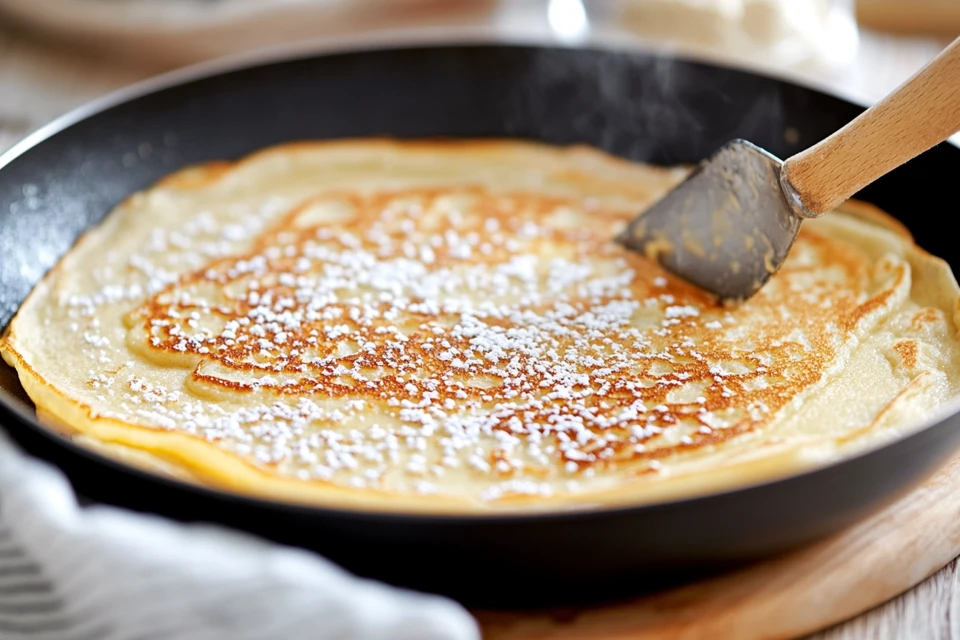
The Art of Making Authentic French Crêpes: Part 2
Continuing our exploration of authentic French crêpes, this section dives into advanced techniques, tips for adapting the recipe to suit dietary needs, and creative ideas for serving and customising crêpes. Whether you’re planning a family breakfast or hosting a French-inspired soirée, these insights will ensure your crêpes impress every time.
11. Choosing the Right Flour for Crêpes
The type of flour you choose significantly impacts the texture and flavour of your crêpes, making it a crucial decision in the preparation process.
All-Purpose Flour vs Buckwheat Flour
- All-Purpose Flour: The standard choice for sweet crêpes, all-purpose flour yields a smooth, delicate texture that pairs beautifully with sugar and sweet fillings.
- Buckwheat Flour: Traditionally used in savoury galettes, buckwheat flour provides a heartier, nutty flavour. It also offers a gluten-free alternative for those with dietary restrictions.
How Flour Affects the Final Result
- The protein content in the flour determines the elasticity of the batter, affecting how easily it spreads and cooks. Buckwheat flour creates crêpes with a slightly coarser texture, while all-purpose flour ensures a soft, pliable crêpe.
12. Secrets to Thin, Delicate Crêpes
The hallmark of authentic French crêpes is their thinness, achieved through attention to batter consistency and cooking techniques.
Adjusting Batter Consistency
- If your batter is too thick, the crêpes will be dense and heavy. Gradually add milk or water to the batter until it is as thin as heavy cream.
- Use a fine sieve to strain the batter, ensuring a silky smooth texture free from lumps.
Swirling Technique
- Pour a small ladleful of batter into the centre of the hot pan and immediately tilt and swirl the pan in a circular motion. This ensures the batter spreads evenly, creating a paper-thin crêpe.
13. Making Crêpes Ahead of Time
Crêpes are an excellent make-ahead dish, as they retain their quality when stored properly.
Storing Crêpes
- Stack cooled crêpes on a plate with sheets of parchment paper between each one to prevent sticking. Wrap the stack in cling film or store in an airtight container.
- Refrigerate for up to 3 days or freeze for up to 2 months.
Reheating Tips
- Gently warm crêpes in a non-stick pan over low heat or in the microwave for a few seconds. Cover with a damp paper towel while reheating to keep them soft and pliable.
14. Customising Crêpes for Different Diets
Crêpes are highly adaptable, making them suitable for a variety of dietary preferences and restrictions.
Gluten-Free Options
- Substitute all-purpose flour with buckwheat flour, rice flour, or almond flour. Ensure the batter rests longer to achieve the right consistency.
Dairy-Free and Vegan Adaptations
- Replace milk with plant-based alternatives such as almond milk, oat milk, or soy milk.
- Use melted coconut oil instead of butter for richness.
- Swap eggs with a flaxseed or chia seed mixture (1 tablespoon flaxseed/chia + 2.5 tablespoons water = 1 egg).
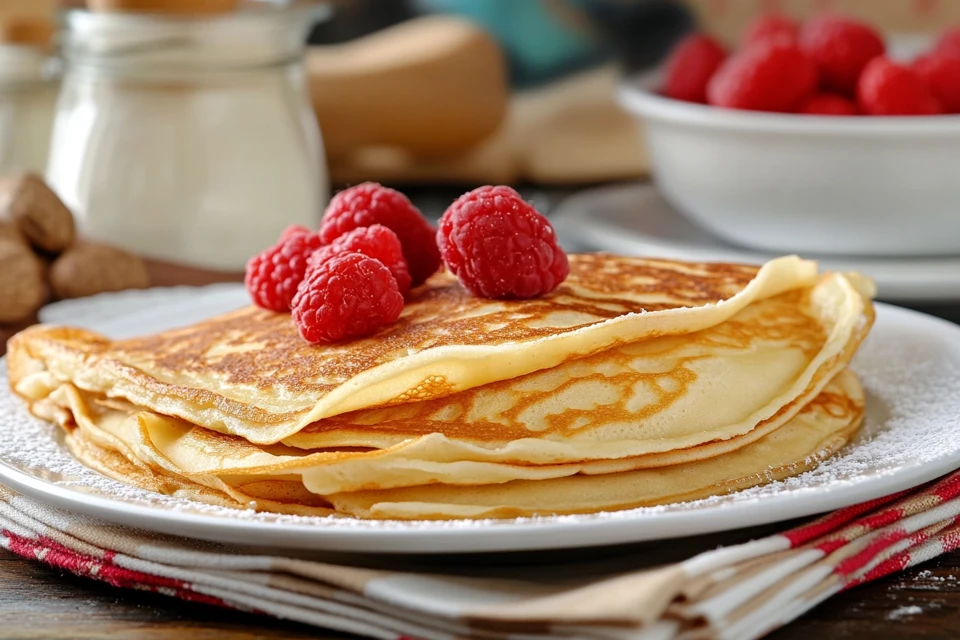
15. Sweet Crêpes for Special Occasions (Authentic French Crêpes)
Crêpes can be dressed up for festive occasions, making them a versatile choice for celebrations.
Decorating for Birthdays or Holidays
- Roll or fold crêpes and top with powdered sugar, whipped cream, and colourful sprinkles for a festive touch.
- Arrange crêpes in a layered stack with fruit, cream, and jam to create a crêpe cake.
Adding Liqueurs
- Infuse your batter or toppings with liqueurs like Grand Marnier, Cointreau, or rum for a sophisticated, gourmet twist.
16. Making Crêpes with Kids
Baking with children is a fun and rewarding activity, and crêpes provide plenty of opportunities for involvement.
Simple Steps for Kids
- Allow children to help whisk the batter or sift the flour.
- Let them spread the batter in the pan or assist with flipping under supervision.
Fun Toppings and Fillings
- Offer an assortment of kid-friendly toppings like chocolate spread, sliced bananas, mini marshmallows, and sprinkles.
- Encourage creativity by letting kids assemble their own crêpe creations.
17. Tips for Avoiding Common Mistakes
Mastering crêpes comes with a learning curve, but these tips will help you avoid common pitfalls.
Preventing Lumps
- Always sift the dry ingredients and mix the batter thoroughly.
- Add wet ingredients gradually while whisking to prevent clumps from forming.
Even Cooking
- Ensure your pan is evenly heated before adding batter. If crêpes are unevenly cooked, it may be due to inconsistent heat.
Handling Sticky or Overcooked Crêpes
- Lightly grease the pan before each crêpe to prevent sticking.
- Avoid overcooking by flipping the crêpe as soon as the edges begin to lift.
18. Serving Crêpes with French Flair
Presentation is everything when serving crêpes, and a touch of elegance can make them feel truly authentic.
Traditional Presentation
- Folded Crêpes: Fold into triangles by folding in half twice, ideal for sweet toppings.
- Rolled Crêpes: Roll crêpes around their filling for a neater, compact presentation.
Finishing Touches
- Dust with powdered sugar, drizzle with chocolate or caramel sauce, or top with a dollop of whipped cream for a polished finish.
19. Pairing Crêpes with Drinks
The delicate flavours of crêpes pair beautifully with a variety of beverages, elevating your meal.
Sweet Crêpe Pairings
- Coffee or Tea: Classic choices that complement the richness of sweet crêpes.
- Sparkling Cider: Adds a refreshing, festive touch to your dessert.
Savoury Crêpe Pairings
- Wine: A crisp white wine or rosé pairs well with savoury galettes.
- Champagne: Adds a luxurious element to any crêpe-based meal.
20. Scaling the Recipe for Large Gatherings
Crêpes are ideal for feeding a crowd, as the batter can be made in large quantities and cooked in advance.
Preparing Batter in Bulk
- Multiply the ingredients while maintaining the same ratios. Store the batter in the fridge until ready to use, giving it a quick whisk before cooking.
Keeping Cooked Crêpes Warm
- Stack cooked crêpes on a heatproof plate and cover with foil. Place in a warm oven (around 90°C) to keep them warm and pliable until serving.
With these advanced techniques and creative ideas, you’re well on your way to mastering the art of authentic French crêpes. Whether you’re catering to dietary needs, creating a show-stopping dessert, or preparing for a large gathering, crêpes offer endless possibilities to impress and delight.
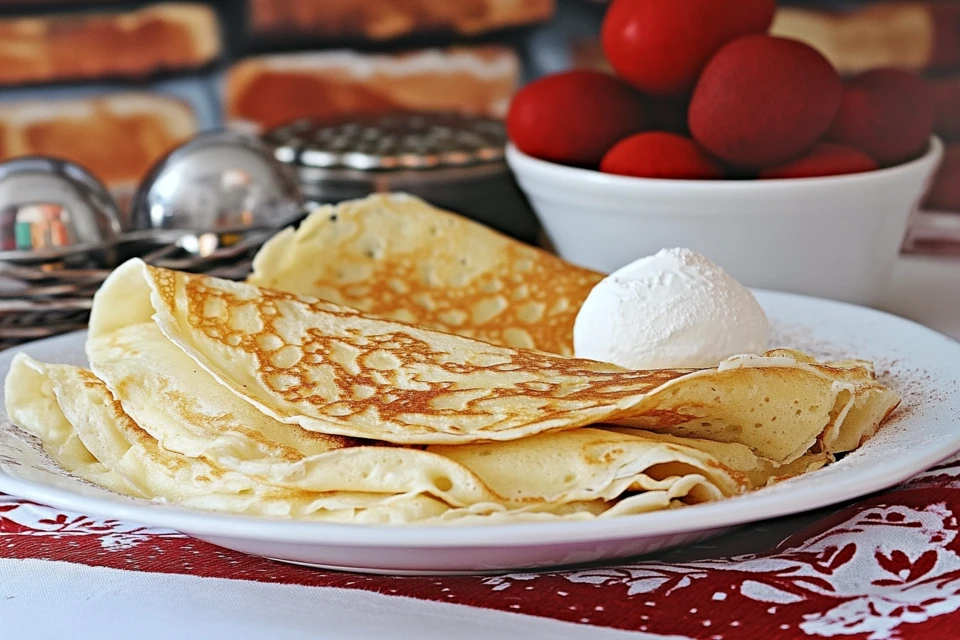
Exploring the Endless Possibilities of French Crêpes: Authentic French Crêpes
French crêpes are not just a culinary delight but a global phenomenon, appreciated for their adaptability and elegance. From the rustic sweet crêpes of Brittany to the hearty buckwheat galettes of Normandy, crêpes showcase the diversity of French cuisine. Yet, their appeal extends far beyond France, with countless variations and interpretations worldwide. Whether you’re preparing them as delicate desserts or savoury meals, crêpes are the perfect blank canvas for creativity.
Regional Variations of French Crêpes
France’s crêpe culture is as varied as its regions. In Brittany, sweet crêpes are made with simple ingredients like flour, milk, and eggs, often served with sugar, butter, or local jams. Meanwhile, Normandy is famous for its savoury buckwheat galettes, which are naturally gluten-free and filled with ingredients like ham, cheese, and eggs. These regional distinctions highlight the versatility of crêpes, making them suitable for both casual and gourmet dining.
Exploring Global Crêpe Variations
Beyond France, crêpes have inspired countless adaptations. The famous Crêpe Suzette, a French dessert flambéed with orange liqueur sauce, remains a pinnacle of indulgence. Internationally, Sweden offers thin pannkakor, often served with lingonberries, while Russia’s blini are smaller, thicker pancakes traditionally paired with sour cream and caviar. Each culture brings its own flair to the crêpe, demonstrating the universal appeal of this versatile dish.
Making Crêpes in Different Pans
The choice of pan can dramatically affect your crêpe-making experience. A non-stick pan is ideal for beginners, as it ensures even cooking and prevents sticking. For more seasoned cooks, a cast iron crêpe pan provides superior heat retention and enhances flavour over time. Electric crêpe makers and griddles are also excellent for achieving restaurant-quality crêpes, allowing for precise temperature control and consistency.
Sweet Crêpe Topping Combinations
The beauty of sweet crêpes lies in their endless customisation options. Classic pairings like fresh berries with mascarpone or caramel with toasted pecans can elevate your dessert to new heights. For special occasions, consider creating a dessert crêpe platter, featuring an assortment of toppings like Nutella, bananas, whipped cream, and fruit compotes. This interactive presentation invites guests to build their own crêpe masterpieces.
Savoury Crêpe Filling Ideas
Savoury crêpes transform a simple batter into a hearty meal. Traditional French fillings like ratatouille, spinach and ricotta, or the classic ham, cheese, and egg combination are timeless options. For a modern twist, try smoked salmon with cream cheese and dill or avocado with roasted vegetables. These versatile fillings allow crêpes to seamlessly transition from breakfast to dinner.
Creating Mini Crêpes for Appetisers
Mini crêpes are perfect for parties, offering bite-sized elegance that can be customised to suit any theme. Sweet options like mini crêpes topped with cream and strawberries or savoury ones filled with smoked trout and horseradish make for delightful canapés. Their small size and versatility make them an instant hit at gatherings.
Mastering Crêpe Suzette
Few crêpe dishes capture the sophistication of French cuisine like Crêpe Suzette. This classic dessert involves preparing thin crêpes in a flambéed orange sauce made with butter, sugar, orange juice, and Grand Marnier. The dramatic act of flambéing not only caramelises the sauce but also adds a theatrical flair, making it a memorable addition to any dinner party.
Making Crêpes a Healthy Meal Option
Crêpes can also be a nutritious and satisfying meal with the right ingredients. Swap white flour for wholemeal flour to boost fibre content, and use natural sweeteners like honey or maple syrup in place of refined sugar. Protein-packed fillings like eggs, chicken, nuts, or Greek yoghurt transform crêpes into a wholesome dish that balances flavour and health.
Decorating Crêpes for Holidays
Celebrate the holidays with festive crêpe decorations. For Christmas, fold crêpes into tree shapes and dust with powdered sugar for a snow-dusted effect. At Easter, use cookie cutters to create bunny or egg shapes, and decorate with pastel-coloured toppings. For Bastille Day, incorporate red, white, and blue elements like strawberries, cream, and blueberries to honour the French flag.
Conclusion: Why Everyone Should Try Authentic French Crêpes
French crêpes are truly a dish for all occasions, offering endless possibilities for both sweet and savoury creations. Whether you’re indulging in a luxurious Crêpe Suzette, exploring global variations, or keeping it simple with sugar and lemon, crêpes are a celebration of versatility and culinary artistry. With a few simple techniques and a touch of creativity, anyone can master this timeless dish and bring a taste of France to their table. Let your crêpe-making journey begin!
